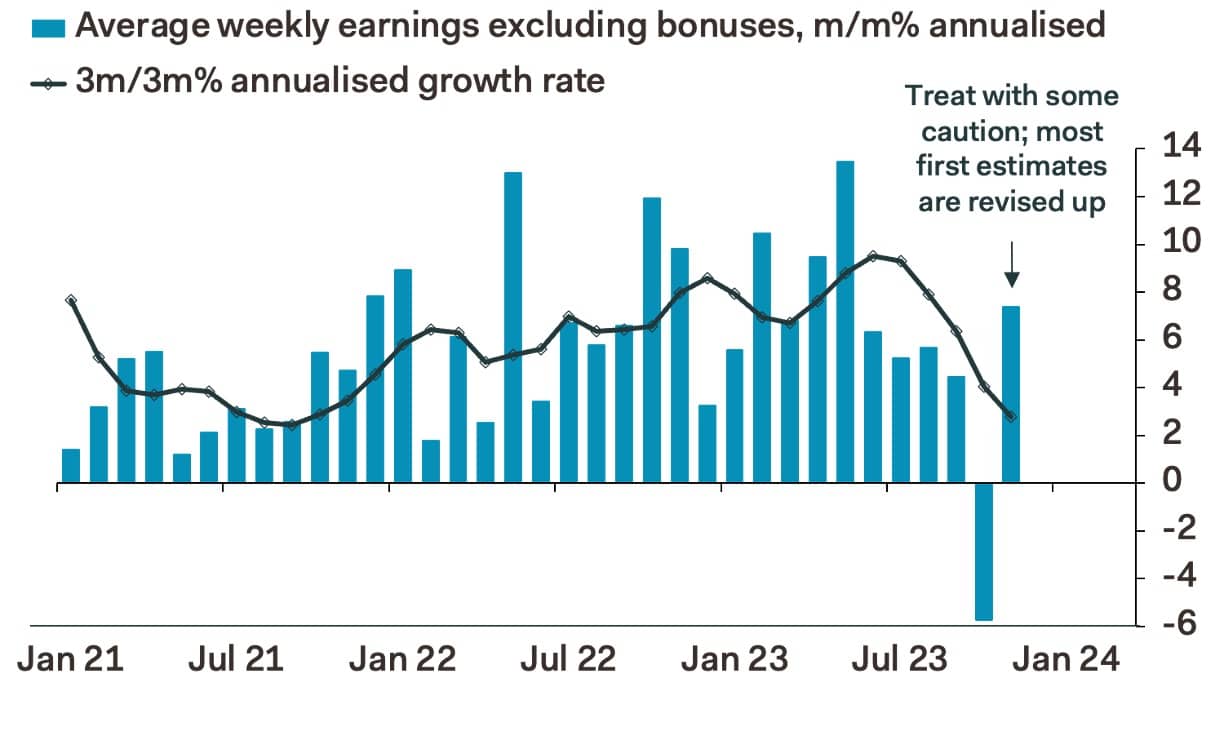Pound Softer Following Wage Data Undershoot
- Written by: Gary Howes
- GBP softer in wake of latest wage data
- Wages come in softer, suggesting Bank of England can cut rates soon
- But, wage declines will be sticky going forward warns one economist
- Accordingly, market is pricing too many cuts
- Any reduction in rate cut bets can support GBP

Image © Adobe Stock
The Brtish Pound fell against the Euro, Dollar and other major currencies after investors bet an undershoot in the official wage figures meant the Bank of England could pursue aggressive rate cuts before long.
The odds of a May rate cut rose after the annual growth in average total earnings (including bonuses) was 6.5% in the September to November period of 2023.
This represents an undershoot against the consensus expectation of 6.8% and is well below the Bank of England's forecasts.
Regular earnings (excluding bonuses) were reported at 6.6% by the ONS, which met expectations.
Reflecting a slight recalibration in Bank of England rate cut expectations following the data release was a softer Pound.
The Pound to Euro exchange rate fell to 1.16 in the minutes following the release, taking the daily move to -0.12%. The Pound to Dollar exchange rate was already under pressure ahead of the UK data release but extended its decline to -0.50% for the day at 1.2663.
Compare Currency Exchange Rates
Find out how much you could save on your international transfer
Estimated saving compared to high street banks:
£25.00
Free • No obligation • Takes 2 minutes
The market is betting the labour market is steadily easing, meaning there are enough job seekers about to fill vacancies and cool wages. This was confirmed after the ONS reported payrolled employee numbers were provisionally estimated to have fallen by 24K month-to-month in December, which is an undershoot of the consensus expectation for -13K.
The Bank of England judges wage increases as being a risk that could ensure inflation remains above the 2.0% level for an extended period and has maintained a desire to keep interest rates at current levels until it is confident domestic inflation will fall sustainably.
Signs of an easing labour market could be found in a 49K fall in the estimated number of vacancies in the final quarter to 934K, albeit they remain above pre-pandemic levels.
Image courtesy of Pantheon Macroeconomics.
However, the ONS says its new experimental calculations reveal the UK unemployment rate is at 4.2%, confirming the jobs market is by no means capitulating.
Samuel Tombs, Chief UK Economist at Pantheon Macroeconomics, says the Bank of England's Monetary Policy Committee (MPC) will proceed cautiously as wages will likely prove sticky.
"The MPC can be more confident that wage gains have slowed following today’s release, but likely still will be too worried about the near-term outlook to signal at next month’s meeting that it will reduce Bank Rate multiple times this year," he says.
Tombs cites several surveys that point to ongoing momentum in wage growth, including the Bank of England's Decision Maker Panel survey that revealed businesses expected to increase wages by an average of 5.4% over the next year.
Year-over-year growth in the PAYE measure of median pay remained at 6.6% in December.
The National Living Wage will rise by 9.8% in April, but Tombs says big employers could offer bigger increases. He says Sainsbury’s recent announcement that it will increase its minimum hourly pay rate by 9.1% in March could set a precedent as it maintains "an unusually large premium" above the National Living Wage.
Tombs says other employers will feel pressured to follow suit.
"We continue to think that it will reduce Bank Rate by 75bp this year, less than the 125bp currently priced-in by investors," says Tombs.
If Pantheon Macroeconomics are correct, the market will price out a rate cuts, which would potentially boost the Pound.
Compare Currency Exchange Rates
Find out how much you could save on your international transfer
Estimated saving compared to high street banks:
£25.00
Free • No obligation • Takes 2 minutes





